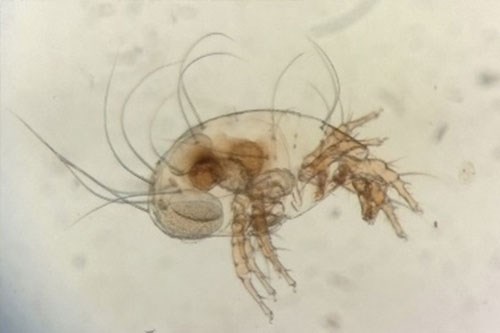Tapeworm In Horses

There are three species of tapeworm known to affect horses, Anoplocephala perfoliata, the most common in the UK, Anoplocephala magna and Anoplocephaloides mamillana.

Tapeworm live in the ileocaecal junction (between the small intestine and large intestine where the caecum is connected) and small intestine. They sucker onto the horse’s gut wall and live off food that that horse ingests.
Symptoms
Saliva testing of horses in the UK has shown that 23% are infected with tapeworm parasites. This is fewer than we once thought but we still need to be vigilant as their presence can result in physical damage to the gut tissue and cause serious problems such as diarrhoea, weight loss and colic.
Testing with EquiSal
The innovative EquiSal test is a simple to use saliva test that detects harmful tapeworm infections in horses. It works by scientifically measuring antibody levels to the tapeworm parasites that the horse produces. This accurately detects levels to give a result of low, borderline or moderate/high and indicates whether treatment is required.
The test was developed by Austin Davis Biologics and is available direct from Westgate Labs. Unlike the ELISA blood test, owners can take samples themselves without the need for a vet using a specially designed saliva collection swab that is inserted into the horse’s mouth.
By combining the test with regular worm counts we can now target treatment to all three parasite groups that are the major threat to horse health. Horses should be tested for tapeworm every 6 months, at least 4 months after the last tapewormer has been given. We also often see tapeworm eggs under the microscope in a worm egg count but the test is not definitive, this is because the eggs are laid in packets. If these burst then eggs are released into the dung but this does not always happen.
> Read More about the validation of the tapeworm test
> Equine Veterinary Journal Paper on the EquiSal test
> Read more about EquiSal Tapeworm test results
Treatment for Tapeworm
If you have used the EquiSal saliva test you will only need to worm for tapeworm if the results indicate that infection is present. Evidence based treatment is by far the best course of action as it saves giving unnecessary chemicals, slowing the build up of resistance to these important drugs as well as being better for the horse’s health and the environment.
Alternatively you could decide to worm routinely. This should be done at least once per year, preferably late in the season. Where there is higher risk of infection, for example where a horse has a known or recurring problem, horses that travel regularly for training or competitions, where herd members change often or where large numbers of horses are kept together, then a second dose should be given six months later.
Tapeworm treatment was traditionally done in spring and autumn, at the start and end of hunting season, when horses were turned out to grass for the summer months. This can prove a useful aide memoir but as long as the gap is six months apart it does not matter when in the year you choose to test.
It can make sense to combine your winter dose for encysted redworm and tapeworm treatment using Equest Pramox between December and February. Alternate the use of praziquantel with double dose pyrantel to slow resistance. Pyrantel will also have some effect on adult stages of redworm.
In rare cases horses with high tapeworm burdens can develop colic following treatment, a syndrome known as post-dosing colic. Veterinary advice should be sought to tackle this burden.
How are horses infected with tapeworms?

Horse tapeworms rely on an intermediate host to spread the infection, an oribatid mite, a tiny creature which lives on grassland and in forage. The horse picks up the tapeworm eggs from his pasture whilst grazing or from hay and straw. The tapeworms are relatively slow growing and take months to grow to maturity in the horse’s gut. Mites are thought to be more common on permanent pastures on acidic soils and less likely on chalky downland or short-term grass leys.